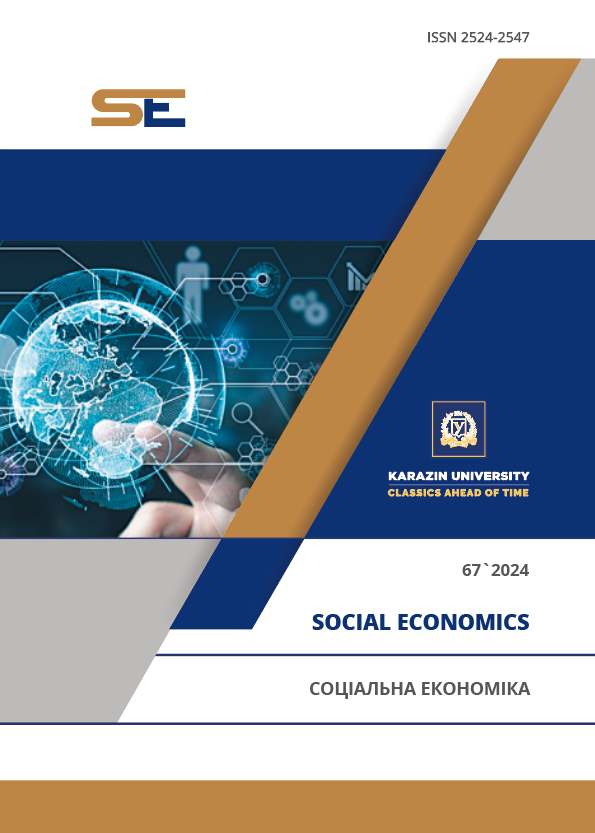DIGITAL TRANSFORMATION AND THE USE OF ARTIFICIAL INTELLIGENCE IN SOCIAL INSURANCE AND INSURANCE
Abstract
The goal of writing this article is to explore the impact of artificial intelligence on enhancing efficiency and ensuring the competitiveness of insurance companies, as well as to uncover the opportunities and advantages, downsides, and challenges of using digital technologies in social insurance and insurance. Digitalization in this field occurs under the influence of globalization, technological innovations, and changes in demographic trends. The study pays special attention to the impact of digital technologies on insurance processes, including the use of big data and artificial intelligence for personalizing insurance products and optimizing risk assessment and claim processing procedures. The research also focuses on analyzing the effects of these changes on social equity and the accessibility of insurance services for different population strata. This article provides a comprehensive view of the trends and prospects for the development of social insurance and insurance, highlighting both theoretical and practical aspects of reforming these systems in the context of modern socio-economic challenges. The research shows that companies that reject innovation will face higher costs in the future compared to those actively implementing new developments. These companies will also face challenges in attracting high-risk clients, whereas innovations help attract more reliable clients who benefit from personalized products. This article demonstrates that through digitalization of insurance, clients become more satisfied and interested in insurance services, which leads to increased insurance premium revenues. Moreover, digital technologies help reduce costs by optimizing decision-making and reducing risks, thereby enhancing the efficiency of insurance operations and strengthening the competitive advantages of insurers. The advantages of digitization and the use of AI include improved accuracy of risk assessment, process automation, product personalization, fraud detection, and enhanced investment decision-making. The downsides may include data confidentiality issues, the exclusion of the human factor, the risk of algorithm bias, implementation complexity and high costs, and the threat of unemployment.
Downloads
References
Porter, M. E., & Heppelmann, J. E. (2014). How Smart, Connected Products Are Transforming Competition. Harvard Business Review, November. Retrieved from https://hbr.org/2014/11/how-smart-connected-products-are-transforming-competition
Linden, V. S. (2018). The Insurtech Book. Hoboken: Wiley. Retrieved from https://www.wiley.com/en-br/The+INSURTECH+Book%3A+The+Insurance+Technology+Handbook+for+Investors%2C+Entrepreneurs+and+FinTech+Visionaries-p-9781119362210
Bazilevych, V. D. (2020). Digitalization for ensuring competitive advantages of insurance companies. Economics and the State, 2, 15-20. doi: https://doi.org/10.32702/2306-6806.2020.2.15 (In Ukrainian)
Mandra, N. H. (2020). The necessity of digital technologies in insurance business processes. Economic Space, 154, 202-206. doi: https://doi.org/10.32782/2224-6282/154-38 (In Ukrainian)
Popova, L. V. (2022). Modern Trends in the Development of Digital Technologies in Insurance. Problems of Modern Transformations. Series: Economics and Management, 5. doi: https://doi.org/10.54929/2786-5738-2022-5-08-02 (In Ukrainian)
Panchenko, O., & Sadchykova, I. (2023). The influence of digital technologies on the development of the insurance business. Problems and Prospects of Economics and Management, 4 (36), 291–301. doi: https://doi.org/10.25140/2411-5215-2023-4(36)-291-301 (In Ukrainian)
Hrytsenko, A., & Burlai, T. (2020). Impact of digitalization on social development. Economic Theory, 3, 24–51. doi: https://doi.org/10.15407/etet2020.03.024 (In Ukrainian)
Prymostka, O. (2018). Life insurance companies marketing strategy in the digital world. Journal of Insurance Markets and Companies, 9, 70-78 doi: http://dx.doi.org/10.21511/ins.09(1).2018.06
Tsohou, A., Diamantopoulou, V., Gritzalis, S., & Lambrinoudakis, C. (2023). Cyber insurance: state of the art, trends and future directions. International Journal of Information Security, 9, 737–748. doi: https://doi.org/10.1007/s10207-023-00660-8
Eti S. & et al. (2024). Insurtech in Europe: identifying the top investment priorities for driving innovation. Financial Innovation, 10, 38. doi: https://doi.org/10.1186/s40854-023-00541-y
Eckert, C., Neunsinger, C., & Osterrieder, K. (2022). Managing customer satisfaction: Digital applications for insurance companies. The Geneva Papers on Risk and Insurance - Issues and Practice*, 47, 569-602. doi: https://doi.org/10.1057/s41288-021-00257-z
de Andrés-Sánchez, J., & Gené-Albesa, J. (2024). Not with the bot! The relevance of trust to explain the acceptance of chatbots by insurance customers. Humanities and Social Sciences Communications, 11, 110. doi: https://doi.org/10.1057/s41599-024-02621-5
Farao, A. & et al. (2023). INCHAIN: a cyber insurance architecture with smart contracts and self-sovereign identity on top of blockchain. International Journal of Information Security, 23, 347–371. doi: https://doi.org/10.1007/s10207-023-00741-8
Tatarintseva, Y., & Strokov, Y. (2023). Modern information technologies in insurance: analysis of advantages and disadvantages, Bulletin of NTU KhPI, 5, 80–83. doi: https://doi.org/10.20998/2519-4461.2023.5.80 (In Ukrainian)
Dominguez Anguiano, T., & Parte, L. (2023). The state of art, opportunities and challenges of blockchain in the insurance industry: a systematic literature review. Management Review Quarterly, 74, 1097–1118. doi: https://doi.org/10.1007/s11301-023-00328-6
Eling, M., Nuessle, D., & Staubli, J. (2021). The impact of artificial intelligence along the insurance value chain and on the insurability of risks. The Geneva Papers on Risk and Insurance - Issues and Practice, 47, 205–241. doi: https://doi.org/10.1057/s41288-020-00201-7
Lanfranchi, D., & Grassi, L. (2020). Examining insurance companies’ use of technology for innovation. The Geneva Papers on Risk and Insurance - Issues and Practice, 47, 520–537. doi: https://doi.org/10.1057/s41288-021-00258-y
Shen, Y., & Zhang, X. (2024). The impact of artificial intelligence on employment: the role of virtual agglomeration. Humanities and Social Sciences Communications, 11(122), 1-14. doi: https://doi.org/10.1057/s41599-024-02647-9
A. M. Best. (2018). Best’s Special Report: Insurers Across the Globe Recognize Innovation Critical for Future Success. Retrieved from https://news.ambest.com/presscontent.aspx?refnum=27127&altsrc=9
Panchenko, O., & Bazilinska, O. (2023). Problems of digitalization of insurance business in Ukraine. Scientific Bulletin of Polissia, 2, 276-288. doi: https://doi.org/10.25140/2410-9576-2023-2(27)-276-288 (In Ukrainian)




